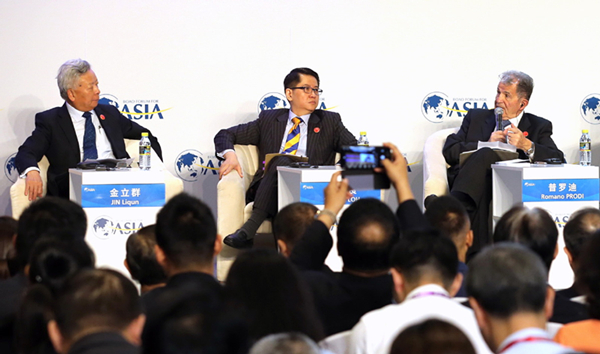
Jin Liqun (first left), president of the Asian Infrastructure Investment Bank, and other guests attend a forum on Belt and Road Initiative infrastructure construction in Boao, Hainan province, on Wednesday. [Photo by Wang Zhuangfei/China Daily]
Both public and private players are encouraged to provide funding for infrastructure construction
China is seeking global partnerships and innovative methods to plug the financing gaps for countries and regions participating in the Belt and Road Initiative to boost infrastructure construction for sustainable development.
Jin Liqun, president of the Asian Infrastructure Investment Bank, said on Wednesday that infrastructure construction is not simply about building roads. The amount of debt, cost recovery and environmental mess are among challenges that need to be looked at.
"Therefore, infrastructure construction cannot clone the model of existing projects. New ideas and new concepts are needed (to address the problems)," said Jin, prior to the Boao Forum for Asia, which officially begins on Thursday.
Jin's remarks came as the BRI, launched six years ago, has been endorsed by more than 100 countries and regions. It mainly aims to build infrastructure facilities including roads, railways and ports to fuel economic growth of countries and regions involved, especially developing countries.
Shamshad Akhtar, a member of the advisory committee for the Belt and Road Forum for International Cooperation, noted that among the committee's current funding, international institutes only make up a small percentage.
"The funding expansion potential is huge. More global participation is needed to involve more people in the issue to offer the funds needed," she said.
According to a report by the Asian Development Bank, the demand for infrastructure across the Asia-Pacific region far outstrips the current supply, with the financing needs expected to exceed $1.5 trillion to $1.7 trillion per year.
To address the problem, Zheng Zhijie, president of China Development Bank, said in Boao that investment and financing of infrastructure projects should be innovated to be "tailor-made" according to different economies and projects.
"Countries and regions participating in the initiative are different economically. It is unrealistic to solve all the financing problems on infrastructure construction through one common model," he said.
Zheng called for efforts to design financing models and product combinations through analyzing the environment of specific projects, the function of the projects and the cash flow situation in different economies.
According to Zheng, the CDB has provided financing of over $190 billion for more than 600 BRI projects since the initiative was launched in 2013. By the end of last year, its total investment in BRI economies was $105.9 billion, accounting for over one third of its overall international business.
Zou Jiayi, vice-minister of finance, added that China also encouraged different development partners to cooperate with BRI economies in financing for "long-term" support.
"The country encourages both multilateral development agencies and private players including public-private partnerships to offer BRI economies financing for long-term and stable development," she said.